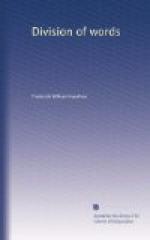35. What considerations govern practice in this regard?
36. Give two systems of division which have been proposed.
37. What is the general rule for division?
38. What is the rule about vowels?
39. What is the rule about two consonants?
40. What is the rule about three consonants?
41. What should you do with a single consonant between two vowels?
42. How should you treat diphthongs?
43. What is the rule for words compounded with a prefix?
44. What should be done with the terminations _-able_, _-ible_, _-tion_, _-cial_, _-tive_, _-ive_, and _-sion_?
45. What should be done with the terminations _-ing_, _-en_, _-ed_, _-er_, and _-est_, and the plural _-es_?
46. What letters should not end a line?
47. How are adjectives in ical treated?
48. How are derivatives of words ending in _-t_ treated?
49. What is the special rule about c and g?
50. What is the rule about qu, and why?
51. What is the rule about nothing?
52. What is the rule about words of four letters?
53. How should you treat words of five or six letters?
54. What should be avoided in wide measures?
55. How should you treat words of two syllables pronounced as one?
56. How should hyphenated compounds be treated?
57. What should you do with divisional marks?
58. How should you treat amounts stated in figures?
59. How should you treat proper names?
60. How are initials and similar combinations treated?
61. What is the rule about the last word on a page?
62. What is the rule about the last word of the last full line of a paragraph?
63. What is the rule about divisions in successive lines?
64. What is the rule about division generally?
65. What effect has spacing on deciding about division?
66. What effect has length of measure on division?
67. What can you do when the text presents unusual difficulty as to spacing and division?
68. What is the rule about division in lines of display, and what is the reason for it?
69. What is the usage with regard to division on title pages?
70. What can you say about eccentricities in the author’s or customer’s ideas about division and lay-out?
* * * * *
As in the other volumes of this Part, the instructor should not content himself with having the student learn the rules. He should give drills in spelling and pronunciation and should give problems in composition involving the application of rules. Constant and prolonged practice is indispensable to proficiency in all these matters.




